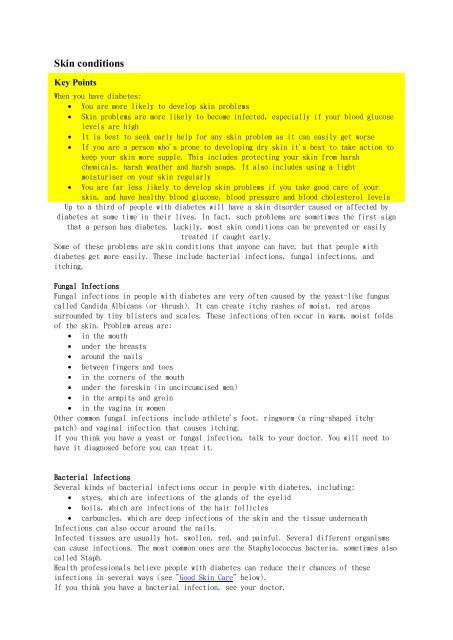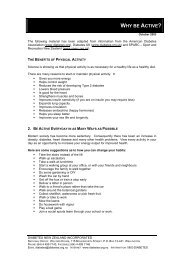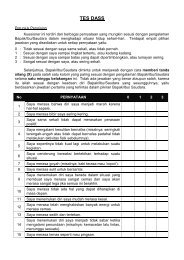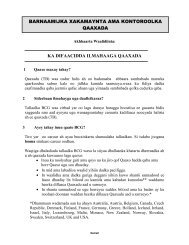Skin conditions - Asian Health Services
Skin conditions - Asian Health Services
Skin conditions - Asian Health Services
Create successful ePaper yourself
Turn your PDF publications into a flip-book with our unique Google optimized e-Paper software.
<strong>Skin</strong> <strong>conditions</strong><br />
Key Points<br />
When you have diabetes:<br />
• You are more likely to develop skin problems<br />
• <strong>Skin</strong> problems are more likely to become infected, especially if your blood glucose<br />
levels are high<br />
• It is best to seek early help for any skin problem as it can easily get worse<br />
• If you are a person who's prone to developing dry skin it's best to take action to<br />
keep your skin more supple. This includes protecting your skin from harsh<br />
chemicals, harsh weather and harsh soaps. It also includes using a light<br />
moisturiser on your skin regularly<br />
• You are far less likely to develop skin problems if you take good care of your<br />
skin, and have healthy blood glucose, blood pressure and blood cholesterol levels<br />
Up to a third of people with diabetes will have a skin disorder caused or affected by<br />
diabetes at some time in their lives. In fact, such problems are sometimes the first sign<br />
that a person has diabetes. Luckily, most skin <strong>conditions</strong> can be prevented or easily<br />
treated if caught early.<br />
Some of these problems are skin <strong>conditions</strong> that anyone can have, but that people with<br />
diabetes get more easily. These include bacterial infections, fungal infections, and<br />
itching.<br />
Fungal Infections<br />
Fungal infections in people with diabetes are very often caused by the yeast-like fungus<br />
called Candida Albicans (or thrush). It can create itchy rashes of moist, red areas<br />
surrounded by tiny blisters and scales. These infections often occur in warm, moist folds<br />
of the skin. Problem areas are:<br />
• in the mouth<br />
• under the breasts<br />
• around the nails<br />
• between fingers and toes<br />
• in the corners of the mouth<br />
• under the foreskin (in uncircumcised men)<br />
• in the armpits and groin<br />
• in the vagina in women<br />
Other common fungal infections include athlete's foot, ringworm (a ring-shaped itchy<br />
patch) and vaginal infection that causes itching.<br />
If you think you have a yeast or fungal infection, talk to your doctor. You will need to<br />
have it diagnosed before you can treat it.<br />
Bacterial Infections<br />
Several kinds of bacterial infections occur in people with diabetes, including:<br />
• styes, which are infections of the glands of the eyelid<br />
• boils, which are infections of the hair follicles<br />
• carbuncles, which are deep infections of the skin and the tissue underneath<br />
Infections can also occur around the nails.<br />
Infected tissues are usually hot, swollen, red, and painful. Several different organisms<br />
can cause infections. The most common ones are the Staphylococcus bacteria, sometimes also<br />
called Staph.<br />
<strong>Health</strong> professionals believe people with diabetes can reduce their chances of these<br />
infections in several ways (see "Good <strong>Skin</strong> Care" below).<br />
If you think you have a bacterial infection, see your doctor.
Itching<br />
Localised itching is often caused by diabetes. It can be caused by a yeast infection, dry<br />
skin, or poor circulation. When poor circulation is the cause of itching, the itchiest<br />
areas may be the lower parts of the legs.<br />
You may be able to reduce itching yourself. Take care not to rub the skin hard when<br />
bathing or showering. Use mild soap with moisturiser and apply a light moisturising skin<br />
cream after bathing.<br />
Dry <strong>Skin</strong><br />
Rough, dry and scaly skin affects most people with diabetes over the age of 60. Dry skin<br />
can be found on particular parts of the body, for example, on the legs, feet, hands and/or<br />
face. Or it can progress to all parts of the skin. In more serious cases the skin loses<br />
its suppleness. It can then crack and become red and inflamed.<br />
Itching is the most obvious symptom. Aside from being irritating, dry skin can be made<br />
worse if you scratch and rub it. Scratching can also lead to infection, or even ulcers.<br />
Often, dry skin is caused by things we cannot control. It often happens in winter because:<br />
• heating your house can lower the humidity (amount of moisture in the air) which can<br />
lead to drying<br />
• cold, dry winter winds tend to dry the skin<br />
Allergic Reactions<br />
Allergic skin reactions can sometimes occur in response to medicines. You should see your<br />
doctor if you think you are having a reaction to a medicine. Be on the lookout for rashes<br />
starting soon after you have commenced a new medicine.<br />
Good <strong>Skin</strong> Care<br />
There are several things you can do to head off skin problems:<br />
• Keep your blood glucose levels in as healthy a range as you can. When your blood<br />
glucose levels are high you are more prone to have dry skin and you are less able<br />
to fend off harmful bacteria. This can increase your risk of infection<br />
• Keep your skin clean and dry. Use talcum powder or anti chaffing cream in areas<br />
where skin touches skin, such as armpits and groin<br />
• Protect your skin. For example, wear gloves when using cleaners, solvents and other<br />
household detergents<br />
• Avoid very hot baths and showers. If your skin is dry don't use bubble baths.<br />
Moisturising soaps may help. After washing, use a light moisturising skin cream<br />
(e.g., BK lotion or Vaseline Intensive Care lotion). But don't put lotions between<br />
your toes. Extra moisture there can encourage fungus to grow<br />
• Where possible prevent dry skin. If you scratch dry or itchy skin it can open up<br />
and infection can set in. Moisturise your skin to keep it supple and prevent<br />
chapping especially in cold or windy weather<br />
• Treat cuts right away. Wash minor cuts with soap and water. Do not use alcohol or<br />
iodine to clean skin because they are too harsh. Only use an antibiotic cream or<br />
ointment if your doctor says it's okay. Cover minor cuts with sterile gauze. See a<br />
doctor right away if you get a major cut, burn, or infection. If you have nerve<br />
damage or poor circulation in your feet you should immediately see a doctor if you<br />
get any sort of cut on your feet<br />
• During cold, dry months, keep your home more humid<br />
• Use mild shampoos and unscented soaps. Do not use feminine hygiene sprays<br />
• See a dermatologist (skin doctor) about skin problems if you or your doctor are<br />
concerned<br />
• Take good care of your feet. Check them every day for sores and cuts. Wear broad,<br />
flat shoes that fit well. Check your shoes for foreign objects before putting them
on<br />
If you'd like more information on skin <strong>conditions</strong> that happen mostly or only to people<br />
with diabetes, go to our "Diabetes-Related <strong>Skin</strong> Conditions" section.<br />
Return to the top of this page . . .











